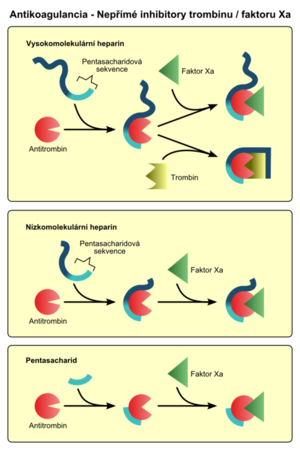Low-molecular-weight heparins
From WikiLectures
Low-molecular-weight or fractionated heparin (LMWH) acts in the early phase of blood coagulation mainly by binding to factor Xa with antithrombin, unlike high-molecular heparin, which also irreversibly blocks thrombin activity.
The main representatives include:
- Nadroparin (Fraxiparine);
- Enoxaparin (Clexane);
- Dalteparin (Fragmin);
- Parnaparin;
- Sulodexide.
- Administration subcutaneously, most often in the abdomen, but it is also possible to administer intravenously in exceptional cases, such as in patients on hemodialysis or with unstable angina pectoris.[1]
- Indications:
- Treatment and prophylaxis of acute deep vein thrombosis and pulmonary embolism (VTE).
- Bridging - bridging the necessary warfarin withdrawal before a planned surgery.[2]
- Comparison to high-molecular-weight heparins:
- Compared to high-molecular-weight heparins, they are safer, have a longer-lasting effect and show significantly fewer adverse effects (heparin-induced thrombocytopenia, bleeding).
Gallery[edit | edit source]
Links[edit | edit source]
Related articles[edit | edit source]
References[edit | edit source]
- LINCOVÁ, Dagmar – FARGHALI, Hassan. Základní a aplikovaná farmakologie. 2. edition. Praha : Galén, 2007. ISBN 978-80-7262-373-0.
- ↑ ZHU, Liqin – LI, Mengxue – LIU, Yihe. Intravenous Administration of Low-Molecular-Weight Heparin. American Journal of Therapeutics. 2019, vol. 26, p. e426-e428, ISSN 1075-2765. DOI: 10.1097/mjt.0000000000000841.
- ↑ KESSLER, Petr. Nízkomolekulární hepariny v ambulantní praxi. Interní medicína pro praxi [online]. 2010, vol. 7, p. 361–365, Available from <https://www.internimedicina.cz/pdfs/int/2010/07/05.pdf>. ISSN 1803-5256.






